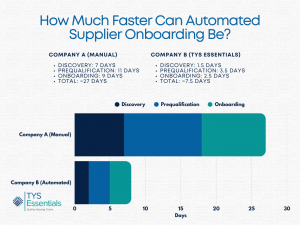Manual vs. Modern: How Supplier Onboarding Shapes Speed, Risk, and ROI
A real-world look at the difference automation makes.

Company A and Company B are both mid-sized, fast-growing businesses with solid procurement teams. Both are trying to source new suppliers under pressure: tight timelines, quality expectations, and critical internal dependencies.
Their goals are the same. But their outcomes? Not even close.
This is what happens when one team is stuck in manual mode and the other is powered by modern supplier onboarding software.
Step 1: Finding the Right Supplier
Company A kicks off its search with Google queries, Slack pings, and industry referrals. The team chases leads across scattered sources, with no way to filter for compliance or certifications.
Company B, using TYS Essentials, searches within a pre-verified network of over 500,000 suppliers. They filter by industry code, location, and risk criteria. In-platform messaging helps them connect directly with suppliers and ask follow-up questions.
🔹 Result: Company B identifies qualified supplier candidates a full week earlier than Company A.
Step 2: Gathering Documents
Company A sends emails and leaves voicemails requesting tax forms, insurance certificates, and licenses. They track responses manually with spreadsheets and inbox folders.
Company B starts with a pre-loaded supplier profile and sends an automated document request through the TYS platform. Suppliers get reminders, and documents are uploaded and timestamped automatically.
🔹 Result: Company B gets complete, verified documentation faster and with fewer errors.
Step 3: Risk & Compliance Checks
Company A uses manual watchlist checks and coordinates with compliance over email and internal chat. It’s time-consuming and hard to track.
Company B runs automated screenings through integrated risk intelligence partners within TYS Essentials. Any red flags are flagged instantly.
🔹 Result: Company B mitigates risk without delaying onboarding.
Step 4: Approvals
Company A sends spreadsheets to Finance and Compliance for approval. There are version control issues and multiple follow-ups.
Company B routes approvals through built-in workflows. Stakeholders are notified, and approvals are logged.
🔹 Result: Company B moves forward in days, not weeks.
Step 5: Supplier Setup & Go-Live
Company A manually inputs banking details and checks for duplicates before sending to A/P. It’s tedious and risky.
Company B uses TYS Essentials' built-in validation tools. Bank data is verified, and duplicates are automatically flagged.
🔹 Result: Company B completes setup securely and ahead of schedule.
Final Score:
By the time Company A finishes onboarding, Company B has already received its first shipment.
The difference is more than speed. It’s about:
✅ Fewer errors and compliance gaps
✅ Better collaboration across teams
✅ Confidence in supplier legitimacy and data

What Could This Look Like for You?
Teams using TYS Essentials report:
- 60% faster onboarding
- 41% less time spent on risk screening
- 17% fewer duplicate suppliers
- 40% reduction in onboarding effort
One energy company even avoided reputational fallout after identifying and replacing a supplier flagged for modern slavery.
Want to know what this could mean for your team?
Try the ROI Calculator to see how much time and money you could save.
Download the Supplier Onboarding Playbook to explore strategies for onboarding in 2025 and beyond.
TYS Essentials makes onboarding faster, safer, and smarter—so your team can focus on the bigger picture.
